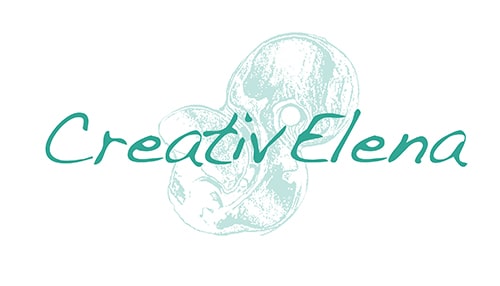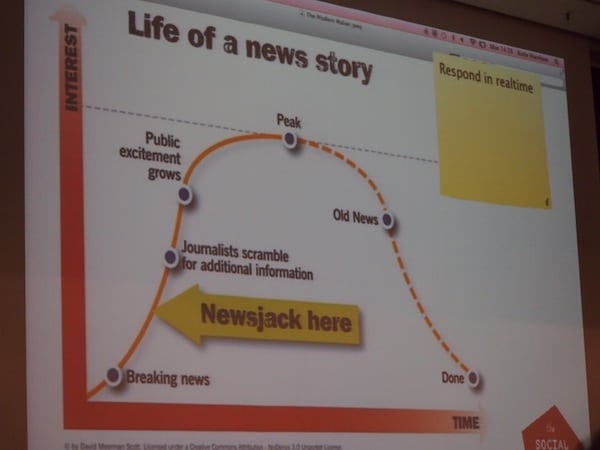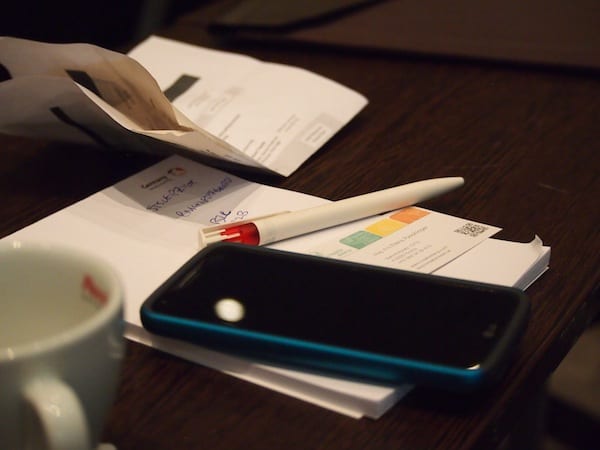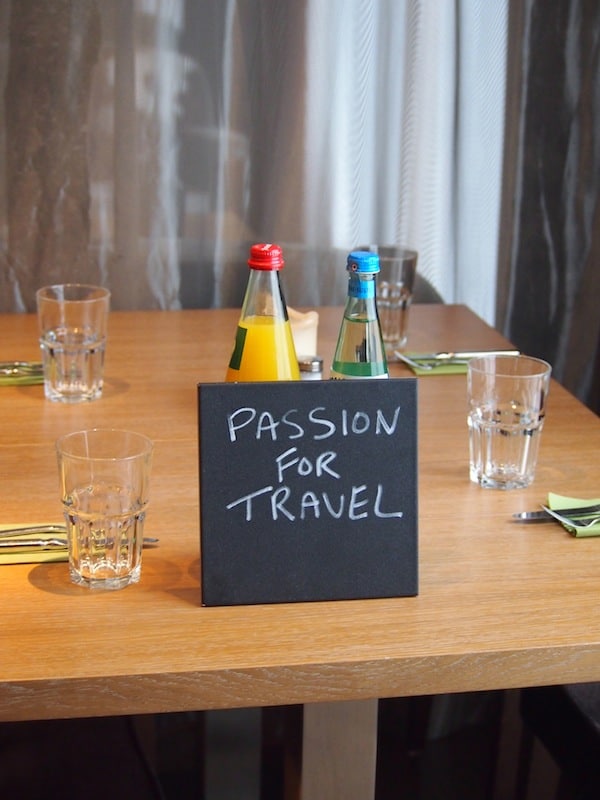@NickWestergaard, of BrandDrivenDigital.com, United States, is a captivating speaker. His presentation merely serves to accompany him in his beautifully crafted expressions, using drama, pause & (rhetoric) questions to hook his audience – that is, us travel bloggers and industry representatives who have come to attend the first ever “Social Travel Summit” in the city of Leipzig from 15-16 April, 2014. And what a summit it was: Quite possibly the best professional summit gathering I have ever been to!

Opening of the Social Travel Summit in Leipzig by co-hosts Keith Jenkins (VelvetEscape, iAmbassador) & Angelika Schwaff (Reisefreunde, ReisebloggerKollektiv).
Let me tell you why this is so, and share with you what I have learned over the last few days. I absolutely believe in the power of sharing as a means to make us all move forward, grow and benefit from each other. So here is what our first keynote speaker Nick Westergaard talked to us about:
Social Media Trends: 7 Hot Topics.
Social Media Trend #1: More content.
“Every two days, we create as much information as we did from the dawn of civilization to up until 2003.” (Eric Schmidt, Google). Online consumers seek out twice as much content as they did before, and a lot more content is produced by the year. So is there already a supply & demand problem? According to Nick, very soon in the next few years we will hit a critical line: There will be more content than eyeballs to watch! Hence, the bars will be raised: We all will have to do more than ever before in order to make ourselves heard.
“We need content that is more strategic, well-written, and visual. The principles of journalism (what, why, when, how, where and who?) continue to apply and help us here. As for strategy, we have to ask ourselves: Do we really know what our consumers want? Did we bother to ask? Up your writing game, everyone! Every good story (even videos) require a script.” (Nick Westergaard, The Social Travel Summit Leipzig)
Social Media Trend #2: Pay to play.
57% of users are currently using paid social media. There are no more free rides on Facebook: Organic reach has shrunk as stock prices of Facebook have gone up. We have to continuously improve and re-evaluate what we do.
Social Media Trend #3: Rapid Relevance.
Have you heard about “real time marketing” under the Social Media buzzword / hashtag #RTM? “Newsjacking“, anyone?! Nick explains to us that modern marketing and creating brand awareness is all about responding in the moment. “Instead of grabbing the news and shoving our brands in them, we have to focus on being fast, and relevant. It is about trust, culture and responsiveness. Build up your own trust and culture.”
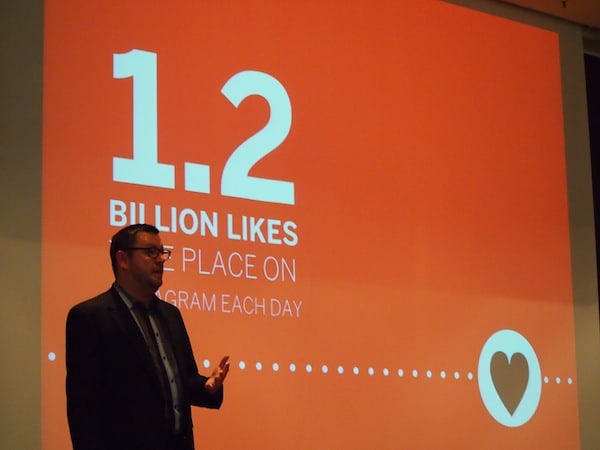
Nick Westergaard, a passionate speaker in his element talking about Top Social Media Trends at The Social Travel Summit in Leipzig.
Social Media Trend #4: Future networks.
At present, we have observed a 20% drop in Facebook usage from teens worldwide. The question is: Where are they going? Is it other Social Media services, such as Vine, Instagram, Flickr, Snapchat (10% of teens worldwide)? I must admit at this point that I have never even heard of Snapchat before: According to Nick, it is a kind of “sneak peek network that … (is all) … about building anticipation. It is less about creating great art, but more about authenticity and exclusivity in the moment. And, especially to young people these days: mobile matters.”
Social Media Trend #5: Mobile & Wearable.
Can you believe the actual 500% rise in Smartphone owners worldwide? 40% of them engage on Social Media, according to a study Nick presents during his speech. 63% of those users are all about image sharing, and 32% of that is video. Mobile shoppers have a much higher conversion rate. So where is the conversation moving to?
The answer Nick has for us is this: Get past the hype (and the jokes) of the likes of “Google Glasses”, “social wearables” and “conversations on your wrist watch”. Change and adapt your behavior by connecting a multitude of trends, such as content growth and rapid relevance.
Social Media Trend #6: Email.
I surely love this phrase: “Emails are the digital cockroaches. They SURVIVE!” Smiles and laughter ripple through the audience at the Social Travel Summit in Leipzig. According to Nick Westergaard, 74% of users prefer receiving important messages via email rather than Social Media. As we progress in the digital (and mobile) age, more and more emails are read on mobile devices rather than on desktop PCs. Part of the reason is that Social Media platforms include a “cautionary tail”: What if they go away? What if the audience base leaves? In order to own your own communication, you need to build your own database! Nick’s advice is to focus on list building, mobile & social integration as the so-called “bread & butter activities: Emails are still the ‘digital glue’. So go out and create better usability about them.”
Social Media Trend #7: Total Brand Experience.
Towards the end of his presentation, Nick asks us how we all feel. Do we feel (overwhelmed? Uhm, yes, just a bit 😉 ). Do we feel the trends he has presented as having a “segregated look” to them? That we should all follow one trend after the other, each of them separately, until we reach “the ultimate goal”?
As you may have guessed, the opposite is true. “Bring all your activities back into a form and make them part of a bigger effort of things. Many things are now coming together to form something new. The top area of Social Media expenditure is all about integration.” As an example, Nick mentions the coffee brand story created under the hashtag #CaribouInspires, whereby a selection of user-collected images was taken to the in-house creative developers, who in turn created a new coffee brew based on visuals from the community. Such the loop went: A conversation that was started online ended offline only to go back online, and go viral! Nick: “This is the future guys! And it has already started.”
His ultimate piece of advice? Don’t get lost in the tools. Continue to focus on relationships. And: We will never really be done with this. Stuff changes constantly. Keep track!
Thank you so much for an excellent presentation Nick!
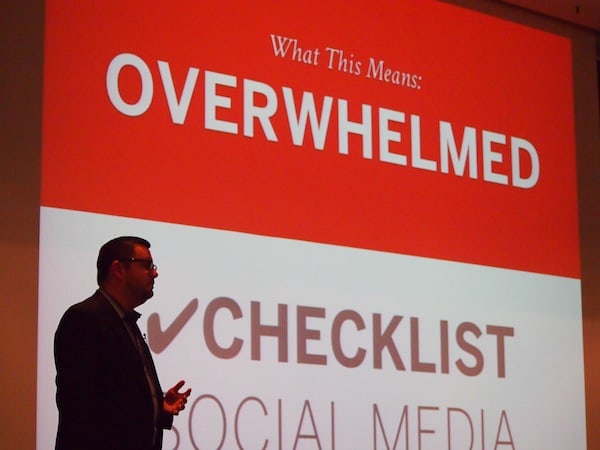
In times of literally being overwhelmed by everything that is out there, checklists & knowing where you are going are some of the most important issues to your business.
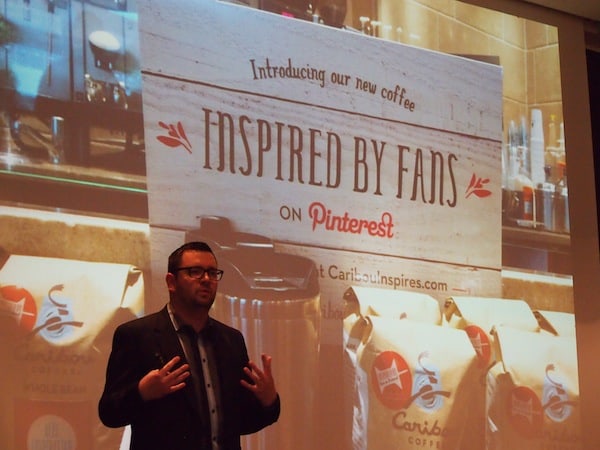
I love the #CaribouInspires coffee story about the integration of online & offline community building / brand awareness creation. Smart & innovative move that one!
Right after, we listen to Simon Andrews (@simonbigpicture @addictivemobile) talking about the “mobile revolution” whereby EVERYTHING IS MOBILE. “Google will rank pages higher when they have a mobile-optimised site.” Modern marketing, according to his opinion, needs to
– put mobile first
– always be social
– truly integrated
– and be obsessed with ROI (return on investment).
Young people are creating better content than production companies. What is digital storytelling and how to tell a really good story?
Katie Harrison, of Wieden + Kennedy London, our third speaker on this Summit Day 1 in Leipzig, speaks to us about employing creativity in digital storytelling. She argues that as a storyteller, you should ask yourself this: Who is your hero? How do you make people like your hero? Empathy, she explains, is the most important thing in human behavior and relationships. So do create a character people care about. Start with a journey: “A wants C but B gets in the way.” Tension, some sort of goal, is so important. It does very much remind me of the fascinating storytelling keynote by Don George I have been to at TBEX Travel Bloggers Exchange conference in Dublin.
She then continues: Know your audience. Use those Facebook insights & Google analytics. Respect your readers’ time and let people know how long your story will take. Be culturally curious: What is happening in the world? Crap often filters up to the top, but you need to know what the wider conversation is. Fill the Internet with beautiful things instead! And finally: Learn how things work. Learn how to use them, and change with them. (Celebrate the art of) making stuff!
As a creative traveller being all about fostering cultural understanding through hands-on, creative workshops and learning experiences, I feel very much accomplished when I hear top speakers such as Katie Harrison talk about the exact same feeling. Thank you Katie for an insightful presentation filled with lots of grand visuals!
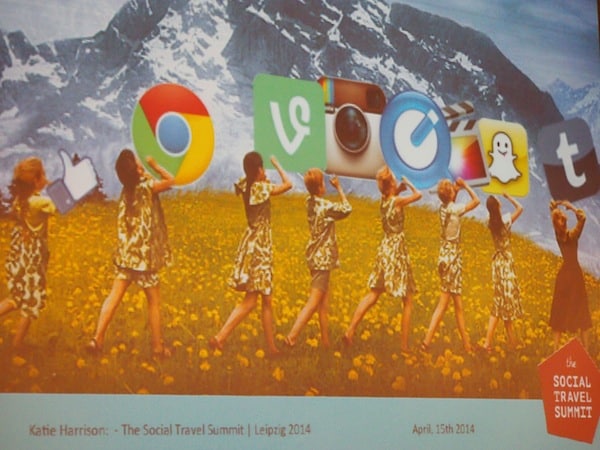
Love the image of “Austrian Sound Of Music Company” (great storytelling known all over the world) mixed with modern Social Media Marketing. As an Austrian, I smile and say: Austria is everywhere!
But the learning does not stop there. Time for (more) questions to & answers from Nick Westergaard, Simon Andrews & Katie Harrison!
Following the inspiring keynote talks by the above-mentioned speakers at The Social Travel Summit in Leipzig, we are all invited to throw in our own questions and have a panel discussion session with the speakers. Alastair McKenzie breaks the ice and causes great laughter when delivering this really fun quote about the history of the Internet, blogging & Social Media: “You just out-dinosaured me, Simon!“, Simon Andrews being in the business even longer than Alastair himself. The first panel question is:
- Will a blog’s personality / discussion move away from the blog site and move to places such as Google Hangouts, Foursquare, etc.?
Nick: “You should always retain your blog personality, something that you own, a virtual business card rather than a (Social Media) channel.” Simon’s piece of advice is this: “Create your content in your own place, and learn how to broadcast it through different channels.” Katie: “Your online presence is your broadcasting station. Consistency is key, e.g. a profile picture that goes across all channels telling about brand and image. The main website (blog) will certainly continue to be important.”
- What potential do you see for travel bloggers collaborating with brands outside the travel sphere?
Katie: “Bloggers are becoming the new hot ticket for brands. Ask yourself: How influential are you, and how good are your stories? There is definitely room for more cross-collaboration. If you run all over the world and talk about the hotspots of excellent running trails, Nike will want to talk with you.” Simon has this to add: “Create, curate, crowd-source. Curating smart people is really the way forward. Important for bloggers at this stage is to remind yourselves: Are you telling your point of view? Do brands distort your authenticity?”
“Authenticity is what you take to the bank. It is (one of) the most important issues for bloggers these days.” (Simon Andrews, The Social Travel Summit, Leipzig).
“Focus what you own. Reach & relevance. Your social footprint is your currency!” (Katie Harrison, The Social Travel Summit, Leipzig).
“Look at where you can get the greatest reach that is relevant to your business partners.” (Nick Westergaard, The Social Travel Summit, Leipzig).
Any media platform is able to package and sell their assets. There has to be a genuine relationship between PR and bloggers: Active collaboration on both sides is required. Bloggers have long been seen as “cheap PR”, and the big marketing budgets never went there. The shift has been achieved through initiatives such as international iAmbassador campaigns or the hosting of very Social Travel Summit itself, and finally word has got out that there is so much more behind it all than “just blogging”, that it is really publishing.
- So how do we invest in bloggers?
Katie: “In advertising, there is so much fear. Kids coming out of university don’t look for agencies as they can start their own companies! The model has to be to work together. My advice to bloggers is this: Treat yourselves as a brand, be a strong force, know your worth & value!”
- What is the #1 mistake bloggers are making right now?
The answers to this question are manifold. “Make it work on mobile! Get the basic things right. Think about other things, such as email communication, too. Focus on those lists! Everyone’s a publisher, but sometimes we are not thinking too much about what that means. Defy the cheap PR notion. Nail consistency across your brand! What is it about you? What makes YOU special? You are selling words, and this is quite a tough business. So what are you actually selling besides that, in the wider scheme of things? And finally: Collaboration is such an important issue. Share your ideas towards other people.”
I love that! Thank you so much for sharing, dear Katie, Nick & Simon. 😀
- Understanding that bloggers are looking to develop a business, what type of technologies should they be playing with right now?
Find the relevance of your voice to any particular platform. Everything is up for grabs, just find the right thing to play with it. Simon: “The new strategy is UBIQUITY.”
- Be everywhere, because you do not know where it is going. Think less about text, because the world is moving VISUAL, to pictures and videos.
- Be everywhere, but be very observing to work out what is happening from each one of them.
- Be everywhere, but be good at being consistent everywhere! Get your best stuff out there, and that is the challenge: To achieve quality, and to be true to yourself.
A blog is a centre of gravity around a passion.
The final words of advice I take from this truly inspiring & interesting panel discussion are these: “Technologies are jaw-droppingly interesting. Make your own manifesto, and put it across all your communication consistently! The big thing is: PLAY. Get excited. Creativity is something the industry will want to follow.”
